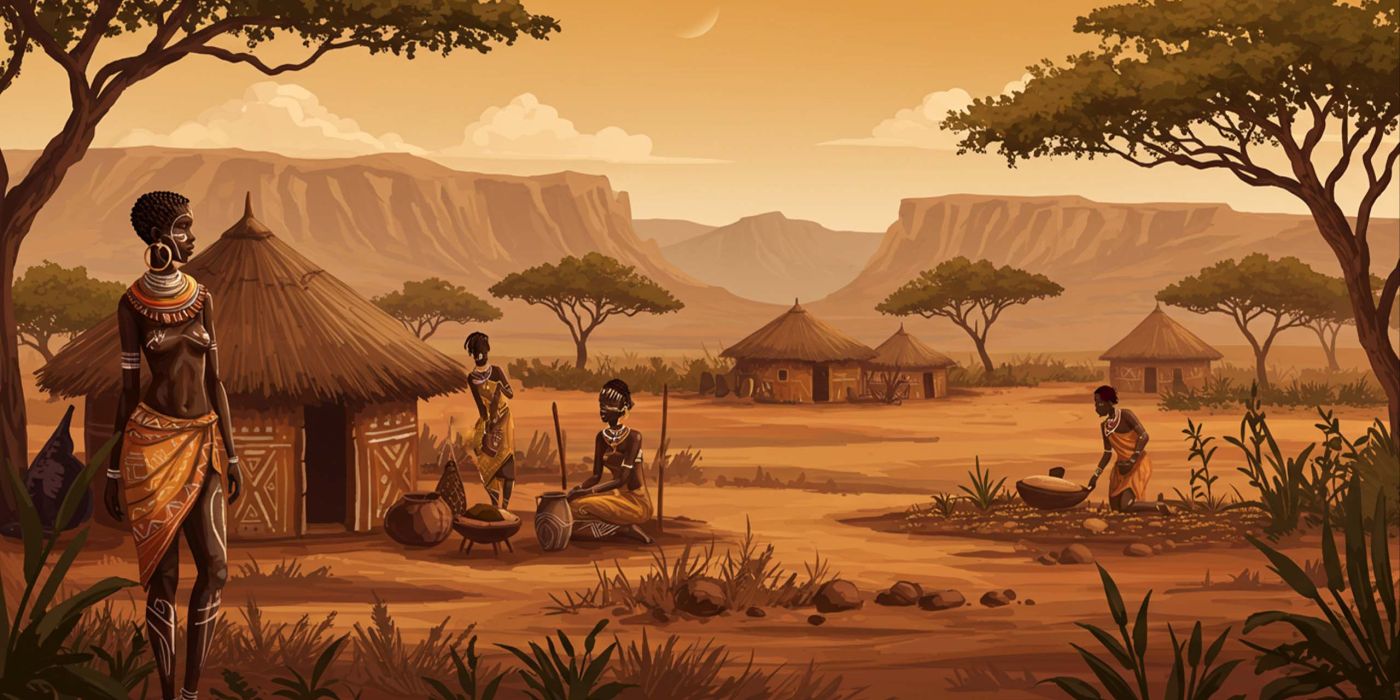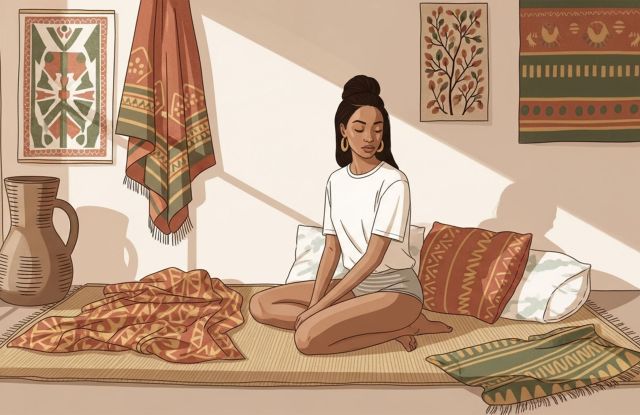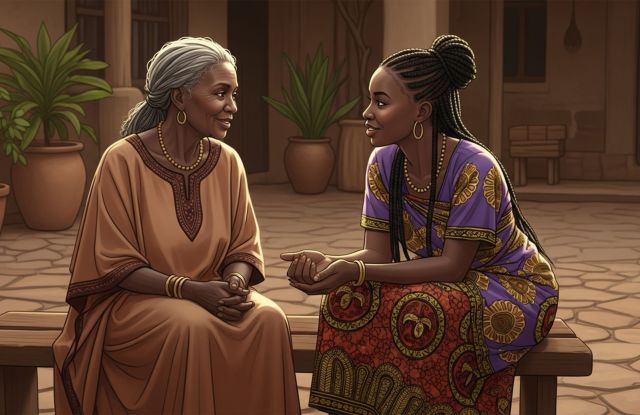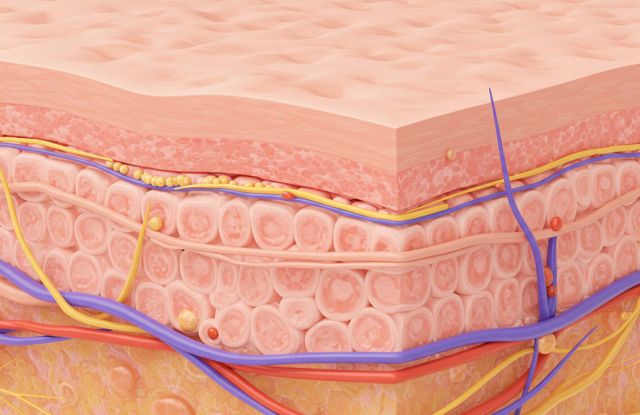
Threads of Tradition: The Ancient Roots of Labia Elongation Across African Landscapes


In the soft hush of a Rwandan dawn, where mist clings to the rolling hills like a whispered secret, a girl named Amina stirs awake. She is young, her limbs still carrying the languid grace of childhood, but today marks a quiet turning point. Her aunt, a woman whose hands bear the calluses of fields and hearths, leads her to the edge of the family compound.
There, under the broad leaves of a banana tree, the lesson begins—not with words alone, but with touch. Gentle fingers guide Amina's own to the delicate folds of her body, teaching her the rhythmic pull that has echoed through generations. "This is for you," her aunt murmurs, her voice steady as the earth beneath them. "For the woman you will become, for the pleasures that await in the arms of a husband, for the harmony of body and spirit." Amina nods, her hands tentative at first, then surer, as the ancient rhythm takes hold. This is *gukuna imishino*, the pulling of the labia minora, a practice as old as the hills themselves, woven into the fabric of life in this corner of East Africa.
To understand such a ritual is to step back into the vast, sun-baked expanse of the continent's history, where bodies were not just vessels for survival but canvases for cultural expression. Labia elongation, the deliberate lengthening of the inner labia through patient manual manipulation, emerges from traditions that predate written records, rooted in the communal wisdom of African societies. It is a story of women shaping themselves—not in isolation, but as part of a shared legacy, where the intimate meets the communal, and personal adornment intersects with collective identity. Far from a uniform practice, it varies across regions, from the arid plains of southern Africa to the lush highlands of the east, each community imprinting its own nuances on this enduring custom.
The earliest whispers of this tradition surface in the encounters between European explorers and the indigenous peoples of southern Africa. In the 17th century, Dutch settlers at the Cape of Good Hope documented what they called the "Hottentot apron" among the Khoikhoi women—elongated labia minora that hung prominently, a feature that both fascinated and bewildered outsiders. These accounts, often laced with the biases of colonial gaze, described lengths reaching up to four inches, attributing them sometimes to nature, sometimes to artifice.
But anthropologists later pieced together a clearer picture: among the Khoisan peoples, including the Nama, this elongation was no accident of birth but a cultivated trait, begun in girlhood under the guidance of elders. Isaac Schapera, in his 1930 ethnographic study *The Khoisan Peoples of South Africa*, detailed how Nama girls, starting very young, and would be taught by an aunt or grandmother to stretch the tissue daily, using simple pulls with fingers or even wooden tools wrapped in softened bark. The process, spanning years, aimed not for exaggeration but for balance—aesthetic symmetry that mirrored the harmony sought in beadwork or scarification elsewhere on the body.
Schapera's work built on even older observations. Captain James Cook, anchoring in Cape Town in 1771, recorded measurements of labia from 1.3 to 10.2 centimeters among Khoikhoi women, noting how the practice was "universal" in certain clans. These weren't idle notations; they hinted at a custom so ingrained that it defined beauty standards, much like the neck rings of the Kayan women in Southeast Asia or the lip plates of the Mursi in Ethiopia. For the Khoisan, whose hunter-gatherer lives revolved around the rhythms of the Kalahari, such modifications spoke to resilience and allure.
Elongated labia were said to enhance grip during intercourse, heightening sensation for both partners—a practical poetry in a world where pleasure was as vital as provisioning the hearth. Men in these communities valued the trait as a mark of maturity and desirability, while women passed it down as a rite of readiness for marriage, ensuring their daughters entered womanhood equipped for the intimacies of union.
As one traces the threads northward and eastward, the practice blooms into fuller expression among Bantu-speaking groups. In the 1930s, British anthropologist Monica Wilson embedded herself among the Nyakyusa of what is now Tanzania, chronicling how girls there initiated the pulling at puberty, often in secretive sessions by the riverbanks. Wilson's notebooks, filled with the cadence of Nyakyusa songs and proverbs, reveal a worldview where the body was a bridge between the physical and the ancestral.
"The long lips hold the man's seed," one elder told her, invoking beliefs in fertility and retention that tied personal anatomy to communal prosperity. Among the Nyakyusa, the elongation was less about spectacle and more about symbiosis—labia lengthened to cradle and stimulate, fostering deeper connections in the marital bed. This wasn't mere folklore; it aligned with broader African cosmologies, where sexuality was celebrated as a force of creation, not shrouded in shame.
Regional Variations in Labia Elongation Practices
| Region/People | Starting Age | Methods | Cultural Significance |
|---|---|---|---|
| Khoisan (Southern Africa) | Girlhood | Manual pulling, wooden tools with bark | Beauty, maturity, enhanced sensation |
| Nyakyusa (Tanzania) | Puberty | Riverbank sessions, manual manipulation | Fertility, marital symbiosis |
| Rwanda (Bantu) | Girlhood | Daily pulling with herbal pastes (e.g., Bidens pilosa) | Pleasure in kunyaza, readiness for marriage |
| Zambia/Malawi | Girlhood | Nighttime pulling, herbal aids | Marital harmony, enhanced grip |
By the mid-20th century, as independence movements stirred across the continent, ethnographers turned their lenses to Rwanda and neighboring lands, uncovering parallels that suggested diffusion over centuries. In Rwanda, *gukuna imishino*—literally "to lengthen the ears of the vagina"—traces its lineage to pre-colonial kingdoms, where court poets wove verses praising women's forms as landscapes of grace. Girls, typically in their teens, learn from maternal kin, pulling for 15 to 20 minutes daily over months or years.
Herbal pastes from plants like the *Bidens pilosa* (blackjack) or aloe soothe the skin, preventing tears and infusing the ritual with the earth's own medicines. The goal? Labia extending three to seven centimeters, ideal for the Rwandan art of *kunyaza*, a foreplay technique of rhythmic vulvar stimulation that prioritizes female climax and even ejaculation, often called *kunyara* or "to make rain." Here, the practice flips Western assumptions: it's women-led, designed for their ecstasy, with men as appreciative participants rather than dictators.
Did You Know?
In some African societies, elongated labia were historically misnamed the "Hottentot apron" by colonial observers, distorting a cultural norm into a symbol of exoticism.
This emphasis on mutual delight echoes in Zambia, where the custom hides behind veils of taboo yet thrives in rural villages. Zambian women, pulling from girlhood under the cover of nightfall, view elongated labia as a secret weapon in love—a silken enhancement that "traps" pleasure, as one anonymous interviewee confided to researchers in a 2015 study. In Malawi and Zimbabwe, similar stories unfold: among the Chewa, it's tied to initiation ceremonies where girls emerge from seclusion with bodies remade, ready for life's dual roles as nurturers and lovers. These aren't isolated pockets; linguistic echoes—like the Swahili *kuchuna* (to pull)—hint at Bantu migrations carrying the knowledge from the Congo Basin southward over a millennium ago.
Yet history rarely unfolds in straight lines. Colonialism cast long shadows, branding these traditions as primitive curiosities. The infamous case of Sarah Baartman, the "Hottentot Venus," paraded in 19th-century Europe for her elongated labia, turned a cultural norm into a symbol of exotic otherness, fueling pseudoscientific racism. Baartman's dissected remains, displayed in a Paris museum until 1974, underscored how external judgments could distort intimate practices. Post-independence, as nations grappled with modernity, the custom faced new scrutiny.
In Uganda, a 2020 clash between the gender minister and traditionalists highlighted the tension: officials labeled it a form of mutilation, while elders defended it as heritage, essential for marital harmony. Surveys show uptake persists—up to 30% of women in some Rwandan districts—often in diaspora communities, from London flats to Johannesburg townships, where grandmothers teach quietly amid the hum of urban life.
"The long lips hold the man's seed," an elder told anthropologist Monica Wilson, reflecting beliefs in fertility and connection that tie anatomy to communal prosperity.
To walk these paths is to confront the universality of body modification. Just as Japanese women bound feet in lotus shoes for elegance or Maori men etched ta moko across faces for status, African women elongated labia as an act of agency within their worlds. It was never about diminishment but amplification—extending not just tissue, but the reach of sensation and connection. In a Zulu proverb, "The river flows from the source," reminding that such customs spring from deep wells of necessity: in societies where marriage sealed alliances and children ensured lineage, a woman's body became a map of preparedness.
Consider Elias, a Zambian farmer in his fifties, sharing stories over millet beer in a Lusaka market. "My wife," he says with a grin that creases his weathered face, "her pulling was the first gift she gave me—not gold or cloth, but the warmth of knowing we fit like hand in glove." His words capture the relational heart of it: for men, it's allure and compatibility; for women, confidence and control. Researchers note psychological layers too—young women who embrace the practice report higher body satisfaction, viewing their forms as tailored instruments of joy rather than generic templates.
Today, as global conversations swirl around consent and health, the tradition adapts without apology. Clinics in Kigali offer guided sessions with medical oversight, blending old ways with new safeguards against infection or asymmetry. Online forums, connect practitioners across borders, sharing tips on sustainable herbs or the emotional hurdles of starting late. It's a living archive, resilient against erasure.
Back in that Rwandan village, Amina grows into womanhood, her hands now expert in the pull. On her wedding day, as drums thrum and guests feast on roasted goat, she steals a moment with her husband, whispering of the traditions that bind them. In her elongated labia, she carries not just her aunt's touch, but the echoes of Khoisan wanderers, Nyakyusa poets, and countless unnamed women who shaped themselves against the horizon. This is the quiet power of origins: not a relic dusted off for display, but a current running beneath the skin, linking past intimacies to future ones. In Africa's vast narrative, labia elongation stands as a testament to how deeply we inscribe our stories on the body—patient, personal, and profoundly human.
Frequently Asked Questions
What is the historical origin of labia elongation?
It traces back to pre-colonial African societies, with early records from 17th-century European explorers noting it among Khoisan peoples in southern Africa.
Is labia elongation still practiced today?
Yes, it persists in rural and diaspora communities across Africa, often adapted with modern health safeguards to ensure safety. Its popularity is also growing in other countries as women, exposed to the practice through migration or cultural exchange, adopt it, in their home countries.
How does it differ from female genital mutilation?
Unlike female genital mutilation (FGM), which often involves forced cutting or removal of tissue, labia elongation is a cultural practice involving gradual, voluntary manual stretching without tissue removal. Taught as a rite of passage by female elders, it is embraced by many practitioners as a consensual act of self-expression and enhancement, rooted in tradition rather than harm.
What cultural roles does it play?
It symbolizes maturity, enhances sexual pleasure for both partners, and fosters marital harmony in traditions like Rwanda's kunyaza.
Has colonialism affected perceptions of this practice?
Yes, colonial accounts often exoticized or pathologized it, as seen in the tragic story of Sarah Baartman, influencing modern views.







